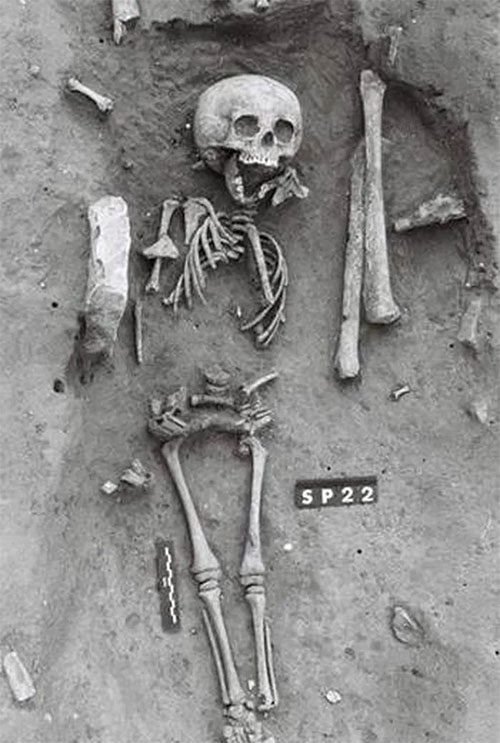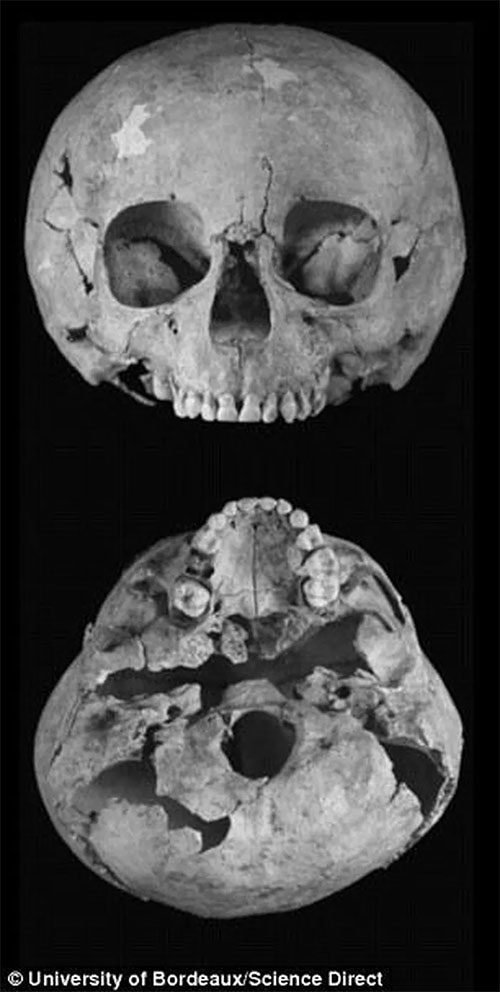On average, one in every 700 newborns worldwide is born with Down syndrome. Have you ever wondered when this condition first appeared? Let’s explore this question together in the following article.
Down syndrome was first described in 1866 and is one of the chromosomal disorders. The cause of this syndrome is the presence of all or part of an extra copy of chromosome 21.
The skeleton of a child aged 5-7 years, who lived in France during the Middle Ages about 1,500 years ago, was discovered during excavations in 1989 alongside 93 other skeletons from a cemetery dating back to the 5th to 6th centuries, located just south of the Saint-Jean-des-Vignes Abbey in northeastern France.

The skeleton of a child showing signs of Down syndrome, discovered in France. (Photo: Live Science).
During the research process, experts examined the results of three-dimensional imaging and brain structure, then compared them with the skulls of 78 other children of the same age. The analysis results indicated that this child exhibited signs of Down syndrome that were absent in the other children.
Among these, the most prominent feature was the short, wide, and flat shape of the skull, as well as thin skull bones and some accessory bone fragments. This child also had an abnormality that could indicate a syndrome disorder when considered alongside other characteristics.

The skull of a 5-7 year old child recently found at the Saint-Jean-des-Vignes cemetery.
The discovery of the skeleton in a burial site alongside many other skeletons suggests that it may have been treated normally and not stigmatized by others. The child was buried face up, with the head facing west and the feet pointing east.
In the history of archaeology, the oldest case of Down syndrome may date back to between 700-900 AD. This is the skull of a 9-year-old child found on Breedon Hill, Leicestershire (England), exhibiting signs of Down syndrome such as a small skull size, thin cranial bones, a small face and upper jaw, a protruding lower jaw, and uneven tooth development. In fact, it represents the earliest archaeological case of Down syndrome, but there is little evidence to convincingly argue it is the first Down syndrome patient.
Additionally, some ancient artworks also depict individuals with this condition from long ago. For example, the painting Virgin and Child with Saints Jerome and Louis of Toulouse, dated 1455, shows a child with small slanted eyes, a wide distance between the eyes, an open mouth, a protruding tongue, and a flat nose.

The painting Virgin and Child with Saints Jerome and Louis of Toulouse depicts a child with small slanted eyes, a wide distance between the eyes, an open mouth, a protruding tongue, and a flat nose.
Another painting titled Madonna della Humilita (circa 1437) by the friar Filippo Lippi also clearly illustrates typical features of Down syndrome.
In 1866, a physician named John Langdon Down (United Kingdom) described this syndrome, and the cause of Down syndrome was discovered in 1959. Subsequently, the name of Dr. John Langdon Down was adopted to designate this syndrome.


















































